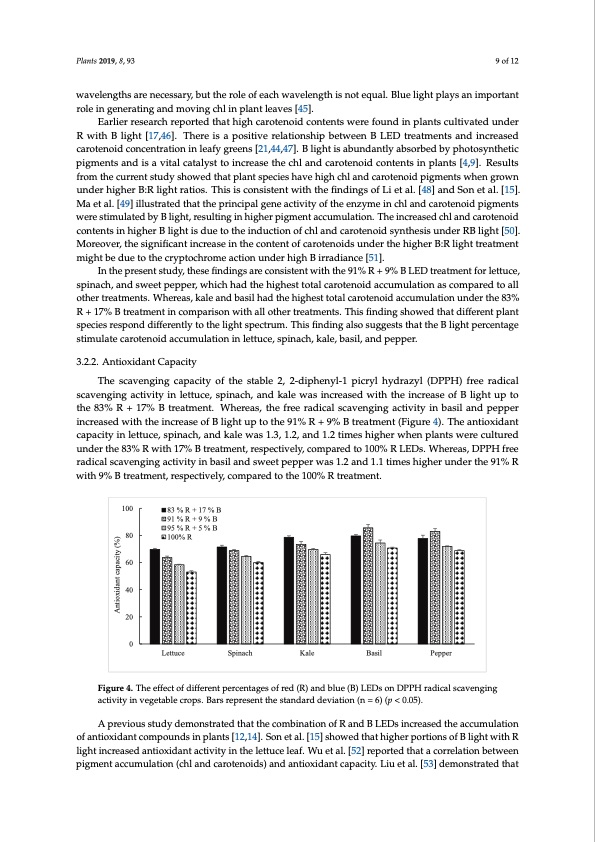
PDF Publication Title:
Text from PDF Page: 009
Plants 2019, 8, 93 9 of 12 wavelengths are necessary, but the role of each wavelength is not equal. Blue light plays an important role in generating and moving chl in plant leaves [45]. Earlier research reported that high carotenoid contents were found in plants cultivated under R with B light [17,46]. There is a positive relationship between B LED treatments and increased carotenoid concentration in leafy greens [21,44,47]. B light is abundantly absorbed by photosynthetic pigments and is a vital catalyst to increase the chl and carotenoid contents in plants [4,9]. Results from the current study showed that plant species have high chl and carotenoid pigments when grown under higher B:R light ratios. This is consistent with the findings of Li et al. [48] and Son et al. [15]. Ma et al. [49] illustrated that the principal gene activity of the enzyme in chl and carotenoid pigments were stimulated by B light, resulting in higher pigment accumulation. The increased chl and carotenoid contents in higher B light is due to the induction of chl and carotenoid synthesis under RB light [50]. Moreover, the significant increase in the content of carotenoids under the higher B:R light treatment might be due to the cryptochrome action under high B irradiance [51]. In the present study, these findings are consistent with the 91% R + 9% B LED treatment for lettuce, spinach, and sweet pepper, which had the highest total carotenoid accumulation as compared to all other treatments. Whereas, kale and basil had the highest total carotenoid accumulation under the 83% R + 17% B treatment in comparison with all other treatments. This finding showed that different plant species respond differently to the light spectrum. This finding also suggests that the B light percentage stimulate carotenoid accumulation in lettuce, spinach, kale, basil, and pepper. 3.2.2. Antioxidant Capacity The scavenging capacity of the stable 2, 2-diphenyl-1 picryl hydrazyl (DPPH) free radical scavenging activity in lettuce, spinach, and kale was increased with the increase of B light up to the 83% R + 17% B treatment. Whereas, the free radical scavenging activity in basil and pepper increased with the increase of B light up to the 91% R + 9% B treatment (Figure 4). The antioxidant capacity in lettuce, spinach, and kale was 1.3, 1.2, and 1.2 times higher when plants were cultured under the 83% R with 17% B treatment, respectively, compared to 100% R LEDs. Whereas, DPPH free radical scavenging activity in basil and sweet pepper was 1.2 and 1.1 times higher under the 91% R with 9% B treatment, respectively, compared to the 100% R treatment. Plants 2019, 8, x FOR PEER REVIEW 10 of 13 100 80 60 40 20 0 83 % R + 17 % B 91 % R + 9 % B 95 % R + 5 % B 100% R Lettuce Spinach Kale Basil Pepper Figure 4. The effect of different percentages of red (R) and blue (B) LEDs on DPPH radical scavenging Figure 4. The effect of different percentages of red (R) and blue (B) LEDs on DPPH radical scavenging activity in vegetable crops. Bars represent the standard deviation (n = 6) (p < 0.05). activity in vegetable crops. Bars represent the standard deviation (n = 6) (p < 0.05). A previous study demonstrated that the combination of R and B LEDs increased the A previous study demonstrated that the combination of R and B LEDs increased the accumulation accumulation of antioxidant compounds in plants [12,14]. Son et al. [15] showed that higher portions of antioxidant compounds in plants [12,14]. Son et al. [15] showed that higher portions of B light with R of B light with R light increased antioxidant activity in the lettuce leaf. Wu et al. [52] reported that a lightincroeraresleadtioannbtieotwxiedeannptigamcteivntitaycciunmthuelalteiotntu(chellaenadf.cWaroutentoaidl.s[)5a2n]dreanptoiorxteidanthtacatpaaciotyrr.eLliautieotnalb.etween [53] demonstrated that the activity of light signal transduction LeHY5 and LeCOP1LIKE genes pigment accumulation (chl and carotenoids) and antioxidant capacity. Liu et al. [53] demonstrated that influence light signalling and stimulate pigmentation and nutritional value, which might eventually positively affect the antioxidant capacity of the plant. Yang et al. [54] demonstrated that LeHY5 and LeCOP1LIKE genes are induced by B light mediated signals similar to CRY1. In the current study, the increased antioxidant capacity can be explained on the basis of the pigment content under the higher B light treatment. These findings also suggest that a combination of R and B LEDs plays a vital role in stimulating antioxidant accumulation in vegetable crops. Antioxidant capacity (%)PDF Image | Blue Light added with Red LEDs Enhance Growth Characteristics

PDF Search Title:
Blue Light added with Red LEDs Enhance Growth CharacteristicsOriginal File Name Searched:
plants-08-00093.pdfDIY PDF Search: Google It | Yahoo | Bing
Cruise Ship Reviews | Luxury Resort | Jet | Yacht | and Travel Tech More Info
Cruising Review Topics and Articles More Info
Software based on Filemaker for the travel industry More Info
The Burgenstock Resort: Reviews on CruisingReview website... More Info
Resort Reviews: World Class resorts... More Info
The Riffelalp Resort: Reviews on CruisingReview website... More Info
| CONTACT TEL: 608-238-6001 Email: greg@cruisingreview.com | RSS | AMP |